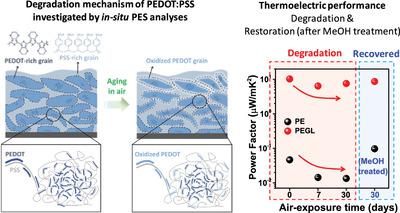当前位置:
X-MOL 学术
›
Adv. Electron. Mater.
›
论文详情
Our official English website, www.x-mol.net, welcomes your feedback! (Note: you will need to create a separate account there.)
In‐Situ Photoelectron Spectroscopy Study on the Air Degradation of PEDOT:PSS in Terms of Electrical and Thermoelectric Properties
Advanced Electronic Materials ( IF 6.2 ) Pub Date : 2020-09-16 , DOI: 10.1002/aelm.202000620 Dong‐Jin Yun 1 , Jaemin Jung 2 , Young Mo Sung 1 , Hyemin Ra 3 , Jung‐Min Kim 3 , JaeGwan Chung 1 , Se Yun Kim 1 , Yong‐Su Kim 1 , Sung Heo 1 , Ki‐Hong Kim 1 , Yong Jin Jeong 4 , Jaeyoung Jang 2
Advanced Electronic Materials ( IF 6.2 ) Pub Date : 2020-09-16 , DOI: 10.1002/aelm.202000620 Dong‐Jin Yun 1 , Jaemin Jung 2 , Young Mo Sung 1 , Hyemin Ra 3 , Jung‐Min Kim 3 , JaeGwan Chung 1 , Se Yun Kim 1 , Yong‐Su Kim 1 , Sung Heo 1 , Ki‐Hong Kim 1 , Yong Jin Jeong 4 , Jaeyoung Jang 2
Affiliation

|
Despite excellent electrical and mechanical properties, practical application of poly(3,4‐ethylenedioxythiophene) polymerized with poly(4‐styrenesulfonate) (PEDOT:PSS) face the challenge of ensuring air stability in electronic industry. Here, degradation mechanism of PEDOT:PSS‐based films in air is clearly demonstrated through X‐ray/ultraviolet photoelectron spectroscopy (XPS/UPS) and its depth‐profiling technique. As the duration of air‐exposure increases, the PEDOT:PSS‐based films alter molecular structures with the formation of SOx bond in PEDOT and CNx bond growth, changing ratios of insulating part (PSS−, PSSH, oxidized PEDOT) to conducting part and deteriorating their electrical conductivities. These transition behaviors are similar in all PEDOT:PSS‐based films regardless of additives such as dopant or multi‐walled carbon nanotube. Additionally, methanol treatment to various PEDOT:PSS‐based films for inducing conformational change between PEDOT and PSS molecules, partly restore the electrical properties of the denatured PEDOT:PSS films. Finally, thermoelectric properties of the PEDOT:PSS‐based films are characterized by investigating the effects of air‐aging and methanol treatment on electrical conductivities, Seebeck coefficients, and power factors. To sum up, this study provides a useful guideline for establishing a strategy to ensure air stability of PEDOT:PSS‐based films by clarifying the degradation mechanism and property recovery methods.
中文翻译:

电学和热电学性质对PEDOT:PSS空气降解的原位光电子能谱研究
尽管具有出色的电气和机械性能,但聚(3,4-亚乙基二氧噻吩)与聚(4-苯乙烯磺酸盐)(PEDOT:PSS)聚合而成的实际应用仍面临着确保电子工业中空气稳定性的挑战。在此,通过X射线/紫外线光电子能谱(XPS / UPS)及其深度剖析技术可以清楚地证明PEDOT:PSS基薄膜在空气中的降解机理。随着空气暴露的增加的持续时间,PEDOT:PSS基于的膜改变分子结构与S的形成 ø X在PEDOT和C键 Ñ X键增长,改变绝缘部分的比率(PSS -,PSSH,氧化的PEDOT)导电部分并降低其电导率。在所有基于PEDOT:PSS的薄膜中,这些过渡行为都是相似的,而与诸如掺杂剂或多壁碳纳米管等添加剂无关。此外,对各种基于PEDOT:PSS的薄膜进行甲醇处理以诱导PEDOT和PSS分子之间的构象变化,部分恢复了变性PEDOT:PSS薄膜的电性能。最后,通过研究空气老化和甲醇处理对电导率,塞贝克系数和功率因数的影响,来表征基于PEDOT:PSS的薄膜的热电性能。综上所述,本研究为通过阐明降解机理和性能恢复方法,确保基于PEDOT:PSS的薄膜的空气稳定性提供了有用的指导。
更新日期:2020-11-19
中文翻译:

电学和热电学性质对PEDOT:PSS空气降解的原位光电子能谱研究
尽管具有出色的电气和机械性能,但聚(3,4-亚乙基二氧噻吩)与聚(4-苯乙烯磺酸盐)(PEDOT:PSS)聚合而成的实际应用仍面临着确保电子工业中空气稳定性的挑战。在此,通过X射线/紫外线光电子能谱(XPS / UPS)及其深度剖析技术可以清楚地证明PEDOT:PSS基薄膜在空气中的降解机理。随着空气暴露的增加的持续时间,PEDOT:PSS基于的膜改变分子结构与S的形成 ø X在PEDOT和C键 Ñ X键增长,改变绝缘部分的比率(PSS -,PSSH,氧化的PEDOT)导电部分并降低其电导率。在所有基于PEDOT:PSS的薄膜中,这些过渡行为都是相似的,而与诸如掺杂剂或多壁碳纳米管等添加剂无关。此外,对各种基于PEDOT:PSS的薄膜进行甲醇处理以诱导PEDOT和PSS分子之间的构象变化,部分恢复了变性PEDOT:PSS薄膜的电性能。最后,通过研究空气老化和甲醇处理对电导率,塞贝克系数和功率因数的影响,来表征基于PEDOT:PSS的薄膜的热电性能。综上所述,本研究为通过阐明降解机理和性能恢复方法,确保基于PEDOT:PSS的薄膜的空气稳定性提供了有用的指导。

























 京公网安备 11010802027423号
京公网安备 11010802027423号